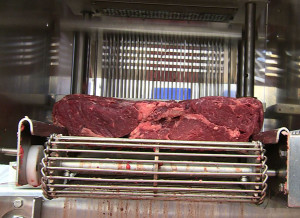South of the border wouldn’t quite make sense living in Australia.
But this was fairly classy for a bunch of hockey folks. And we’re building the game in Australia.

Ron Morais of Fredericton says he got more than he bargained for when he picked up a cup of coffee from a local McDonald’s restaurant on his way to work.
 He was contendedly sipping his coffee that he got Monday from the Prospect Street location until he got to the bottom of the paper takeout cup.
He was contendedly sipping his coffee that he got Monday from the Prospect Street location until he got to the bottom of the paper takeout cup.
“I always take the lid off to get my last sip of coffee. And when I took the lid off, there was a little bit of a surprise in my coffee cup. It was a dead mouse,” Morais said.
Morais said that wasn’t all that was in the cup. He said the mouse left “a few little, shall we say, presents” at the bottom of it.
Morais then showed a few of his co-workers what he had found.
“Unless I had been there and seen Ron drink all that coffee down to the last drop, I would have been, like, ‘You’re lying,’” said one colleague, Brad Patterson.
Jennifer LaHaye, another co-worker who saw the mouse, recalls Morais’s reaction.
“’Oh my God, there’s a mouse in my coffee,’ is what he says. I turn around and look at him. The first time I looked, I actually looked and it’s really, he’s not joking,” LaHaye said.
“Like is he OK — and after that, I got green to the gills.”
Jason Patuano, the communications manager for the eastern region for McDonald’s Canada, issued a corporate statement that underscored how seriously the chain takes food safety.
“We take allegations involving cleanliness and sanitation very seriously,” the statement said.
“Upon learning of this situation, the local franchisee immediately began an investigation, including working closely with the local public health authority who conducted an inspection this [Tuesday] morning following receiving a complaint.”
The Government of Canada verifies that food produced and/or sold in Canada meets federal food safety standards to ensure Canadians have confidence in what they buy. The Canadian Food Inspection Agency (CFIA) monitors and regulates food products that are produced domestically and moved inter-provincially, or are imported.
 Within Canada, all food products must comply with the Food and Drugs Act and Regulations, which set out criteria for safe food and clearly prescribe restrictions on the production, importation, sale, composition and content of food.
Within Canada, all food products must comply with the Food and Drugs Act and Regulations, which set out criteria for safe food and clearly prescribe restrictions on the production, importation, sale, composition and content of food.
The National Microbiological Monitoring Program (NMMP) is one of many tools utilized by the CFIA to verify that domestically produced and imported products meet Canadian standards. It is designed to sample and test a broad range of imported and domestic commodities for multiple hazards, including microbial hazards and extraneous material. The testing carried out under the NMMP covers red meat and poultry products, shell eggs and egg products, dairy products, fresh fruits and vegetables and processed fruit and vegetable products.
As CFIA focuses its monitoring activities towards specific food-related hazards that may impair the health and safety of Canadians, it is important to note that most testing is in commodities that are not further processed by the consumer as well as in raw food, that if not properly cooked, can lead to illness. It is generally accepted that proper precautions taken in the home will destroy any bacteria that may be present.
During the 2011/12 fiscal year under the NMMP, 14307 tests were performed on 5234 domestic and imported products. Specifically, 9049 tests were performed on 3678 domestic products and 5258 tests were performed on 1556 imported products to verify they were compliant with Canadian standards. Results indicated that domestic products were 99.0% compliant and imported products were 98.0% compliant. Overall, a 98.7% compliance rate for combined domestic and imported products was observed.
In addition to testing food products, wash water samples and surface swabs taken within the food production environment are used to verify that food products are produced under sanitary conditions. This type of environmental sampling was performed in domestic establishments to verify the operator systems’ ability to control the presence of pathogens within the processing environment. During 2011/12, there were 2300 tests performed on 1878 environmental samples which were assessed as 97.5% compliant.
The results of the 2011/12 NMMP sampling activities demonstrate that the products available in the Canadian marketplace are for the majority compliant with national standards.
CBC News reports that tampered potatoes from P.E.I. have reached other parts of Atlantic Canada.
 Over the last few days, police received three reports of tampered potatoes, one in Neil’s Harbour, Nova Scotia, one in Musgrave Harbour, Newfoundland and one in Chance Cove, Newfoundland.
Over the last few days, police received three reports of tampered potatoes, one in Neil’s Harbour, Nova Scotia, one in Musgrave Harbour, Newfoundland and one in Chance Cove, Newfoundland.
All the potatoes contained a metal object.
Police believe the potatoes originated from Linkletter Farms in P.E.I.
In all three of the most recent instances, the foreign metal objects were discovered prior to consumption and no one was injured.
With the latest reports, this makes five reports so far of metal objects found in potatoes packaged at Linkletter Farms.
All the tampered potatoes were on a voluntary recall list issued by the Canadian Food Inspection Agency, October 7.
Background: Identification and control of multi-jurisdictional foodborne illness outbreaks can be complex because of their multidisciplinary nature and the number of investigative partners involved.
 Objective: To describe the multi-jurisdictional outbreak response to an E. coli O157:H7 outbreak in Canada that highlights the importance of early notification and collaboration and the value of centralized interviewing.
Objective: To describe the multi-jurisdictional outbreak response to an E. coli O157:H7 outbreak in Canada that highlights the importance of early notification and collaboration and the value of centralized interviewing.
Methods: Investigators from local, provincial and federal jurisdictions, using a national outbreak response protocol to clarify roles and responsibilities and facilitate collaboration, conducted a rapid investigation that included centralized re-interview of cases, descriptive methods, binomial probability, and traceback findings to identify the source of the outbreak.
Results: There were 31 laboratory confirmed cases identified in New Brunswick, Nova Scotia, and Ontario. Thirteen cases (42%) were hospitalized and one case (3%) developed hemolytic uremic syndrome; there were no deaths. Due to early notification a coordinated investigation was initiated before laboratory subtyping was available. Re-interview of cases identified 10 cases who had not initially reported exposure to the source of the outbreak. Less than one week after the Outbreak Investigation Coordinating Committee was formed, consumption of shredded lettuce from a fast food chain was identified as the likely source of the illnesses and the implicated importer/processor initiated a precautionary recall the same day.
Conclusion: This outbreak investigation highlights the importance of early notification, prompt re-interviewing and collaboration to rapidly identify the source of an outbreak.
Canada Communicable Disease Report CCDR
Tataryn J, Morton V, Cutler J, McDonald L, Whitfield Y, Billard B, Gad RR and Hexemer A
http://www.phac-aspc.gc.ca/publicat/ccdr-rmtc/14vol40/dr-rm40s-1/dr-rm40s-1-ecoli-eng.php
We decided to forgo the Canadian Thanksgiving this year for the first time – ever.
 Two intense weekends of hockey, jobs, school, and turkey about $5 a pound (although they walk around the neighborhood and Amy could take one out with a crossbow and clean it in no time except they’re a protected species in Australia) means maybe I’ll use up the can of Spam.
Two intense weekends of hockey, jobs, school, and turkey about $5 a pound (although they walk around the neighborhood and Amy could take one out with a crossbow and clean it in no time except they’re a protected species in Australia) means maybe I’ll use up the can of Spam.
And we’ll aim for the American one.
Funny or Die has its own take on my favorite celebration of the harvest.
In addition to being Indigenous Peoples’ Day, today is also another important holiday: Canadian Thanksgiving (or as they call it in Canada, “Canadian Thanksgiving”). To understand how our northern neighbor’s version of the holiday differs from our own, consume the following Fact Blast:
FoodNet Canada tracks illnesses of the gut, commonly known as food-poisoning, in Canadians and traces them back to their sources, such as food, water and animals. These data are analyzed to help determine which sources are causing the most illness among Canadians and helps us track illnesses and their causes over time.
![HappyCow[1]](https://barfblog.com/wp-content/uploads/2014/09/HappyCow1-239x300.jpg) In the 2013 surveillance year, FoodNet Canada was active in two areas: the Region of Waterloo Public Health, and the Fraser Health Authority of lower mainland British Columbia (BC). In each location, or “sentinel site”, enhanced human disease surveillance is performed in parallel with active surveillance of specific bacteria, viruses and parasites and the possible sources to which the ill may have been exposed.
In the 2013 surveillance year, FoodNet Canada was active in two areas: the Region of Waterloo Public Health, and the Fraser Health Authority of lower mainland British Columbia (BC). In each location, or “sentinel site”, enhanced human disease surveillance is performed in parallel with active surveillance of specific bacteria, viruses and parasites and the possible sources to which the ill may have been exposed.
The purpose of this report is to present the preliminary findings from the 2013 surveillance year in both sentinel sites. This report will be followed by a comprehensive annual report which will include more extensive analyses of temporal trends and subtyping information for an integrated perspective on enteric disease from exposure to illness. With eight years of data from two different sentinel sites, FoodNet Canada continues to provide important information on enteric disease in Canada. This information is essential to develop robust food and water safety policies in Canada.
In a move to cut risk from foodborne E. coli, all mechanically tenderized beef (MTB) sold in Canada from today on must be labelled as such and list instructions on safe cooking.
 Health Minister Rona Ambrose on Thursday announced the new labelling requirements for all uncooked MTB — expanding a rule that’s been in place since July last year for federally licensed beef plants producing steaks and roasts.
Health Minister Rona Ambrose on Thursday announced the new labelling requirements for all uncooked MTB — expanding a rule that’s been in place since July last year for federally licensed beef plants producing steaks and roasts.
The new label must clearly state the beef being sold is “mechanically tenderized,” and must include instructions for safe cooking, stressing the importance of cooking MTB to a minimum internal temperature of 145 F (63 C) and turning over steaks at least twice during cooking.
The Canadian Food Inspection Agency (CFIA) is tasked with verifying retailers’ and packers’ labels meet the new requirements, Health Canada said.
Mechanical tenderization is a common practice for improving beef tenderness and flavour, using needles or blades to break down, penetrate or pierce the meat’s surface and disrupt the muscle fibers, or to inject the meat with a marinade or tenderizer.
 Normally, the risk of E. coli contamination from a rare or undercooked steak, roast or other solid cut of beef is “not a significant concern” since such bacteria would normally be on the surface of the meat and “inactivated” during cooking.
Normally, the risk of E. coli contamination from a rare or undercooked steak, roast or other solid cut of beef is “not a significant concern” since such bacteria would normally be on the surface of the meat and “inactivated” during cooking.
Much like grinding beef, mechanical tenderization can increase the potential for bacteria to transfer from the surface to the centre of the meat.
Unlike ground beef, however, as a Health Canada health risk assessment pointed out last year, it’s “not necessarily apparent by just looking at a mechanically tenderized meat product that it has undergone this process.”
The May 2013 assessment showed “a five-fold increase in risk from MTB products when compared to intact cuts of beef.”
Health Canada noted that in 2012, out of 18 cases of foodborne E. coli O157-related illness from a Canadian outbreak linked to contaminated beef, five cases were considered to be “likely associated with the consumption of beef that had been mechanically tenderized at the retail level.”
The rule covers all solid cuts of MTB, regardless of thickness, which means it will also apply to cubed steaks, “fast fry” or “minute” steaks. It will apply to both pre-packaged and non-pre-packaged products.
MTB that’s packaged on the premises at selection or purchase — such as in a butcher shop or at a clerk-served meat counter — will need to be identified as such before the customer selects a desired cut of beef. An in-store sign would identify a product in a display case as “mechanically tenderized,” for example.
In those cases, once meat has been packaged to give to the customer, the product must carry both the mandatory “mechanically tenderized” label and safe cooking instructions on the “principal display panel.”
The Globe and Mail, based in Toronto and self-proclaimed public record of all thing Canadian, used to be decent. There are still good people there, and some are my friends.
Jason Tetro, a similarly self-proclaimed microbiologist, writes that the first investigations in 2002 focused on comparisons between locally and organically grown foods and those sold in large grocery stores. The results revealed those who chose foods grown closer to home were more likely to have a safer supply with less pesticides, better food quality and, more importantly, less post-harvest handling, which is known to be a significant factor in foodborne infection spread.
No.
By 2010, these differences were solidified as being the basis for better microbiological quality in local foods. Researchers searched for the reasons behind foodborne outbreaks and found links to several well-known problems associated with large-scale farming. …
The most meaningful comparison for consumers comes in the form of statistics. Outbreaks resulting from large-scale farming continue to grab headlines both in the media and scientific literature. In contrast, only a few outbreaks resulting from eating locally grown food have been recorded. In these rare cases, the problems were the result of a significant environmental change, such as a major rain storm or flood. There were almost no cases of local malpractice leading to infection.
This is bullshit.
The only meaningful comparison, statistically speaking, would be to compare incidence of foodborne illness per capita – on a meal eaten basis.
And then he cites the bullshit clean, cook. chill separate, ideology without the source food from safe sources, from farmers who know what they’re doing bit.
The Canadians were busy today, when most of them are off at the cottage.
The Public Health Agency of Canada has joined with the U.S. and now estimates that each year about 1 in 8 Canadians (4 million people) get sick from the food they eat (used to be 1-in-3, or 1-in4).
 Four pathogens cause about 90% of the 1.6 million illnesses caused by known pathogens: Norovirus (1 million cases), Clostridium perfringens (177,000 cases), Campylobacter (145,000 cases) and nontyphoidal Salmonella (88,000 cases). These estimates are based on multiple complementary disease surveillance systems and the peer-reviewed literature.
Four pathogens cause about 90% of the 1.6 million illnesses caused by known pathogens: Norovirus (1 million cases), Clostridium perfringens (177,000 cases), Campylobacter (145,000 cases) and nontyphoidal Salmonella (88,000 cases). These estimates are based on multiple complementary disease surveillance systems and the peer-reviewed literature.
Understanding the burden of foodborne illness is useful for decision-makers, supporting the development of food safety and public health interventions, for research and for consumer education. Future efforts will focus on estimating the number of foodborne hospitalizations and deaths, the economic cost of food-borne illness and the burden of water-borne illness in order to provide crucial information to support research, policy and action.
A guidance document, Weight of Evidence: Factors to Consider for Appropriate and Timely Action in a Foodborne Illness Outbreak Investigation was developed to assist federal government decision-makers weigh the scientific evidence collected during a foodborne illness outbreak investigation in order to inform risk mitigation actions.
The objective of the document is to provide guidance on how to weigh evidence collected during epidemiologic, laboratory and food safety investigations in a food-borne illness outbreak investigation, as part of an overall health risk assessment process carried out by Health Canada. This is a short summary of the document.
And, to highlight the Public Health Agency of Canada’s Foodborne Illness Outbreak Response Protocol (FIORP), the primary guidance document for investigations of multi-jurisdictional food-borne illness outbreaks in Canada.
Approach: The current version of the FIORP was developed in 2010 by the Public Health Agency of Canada following consultation with Health Canada, the Canadian Food Inspection Agency, and provincial and territorial stakeholders.
Results: The FIORP outlines guiding principles and operating procedures to enhance collaboration and coordination among multiple investigative partners in response to multi-jurisdictional food-borne illness outbreaks. It has provided guidance for the conduct of 22 such investigations led by the Public Health Agency of Canada’s Centre for Food-borne, Environmental and Zoonotic Infectious Diseases between 2011 and 2013. Furthermore, it has also served as a guide for the development of provincial protocols.
Conclusion: The timely and effective investigation of and response to multi-jurisdictional food-borne illness outbreaks in Canada is facilitated and enhanced by the FIORP.
Of course, none of these documents were peer-reviewed and published in scientific journals, so it’s just a lot of back-slapping.